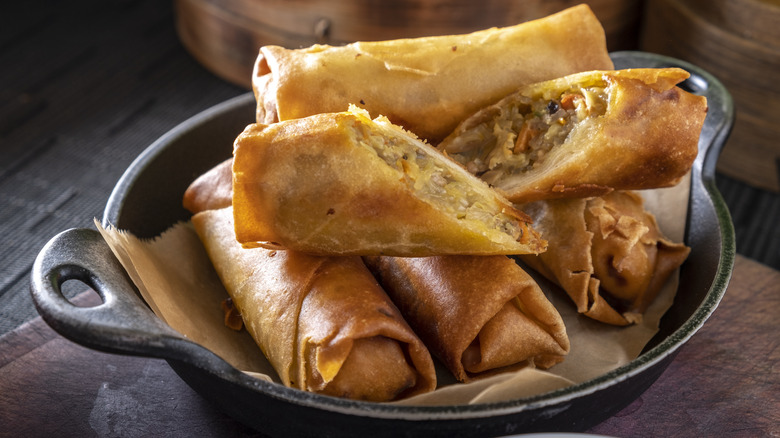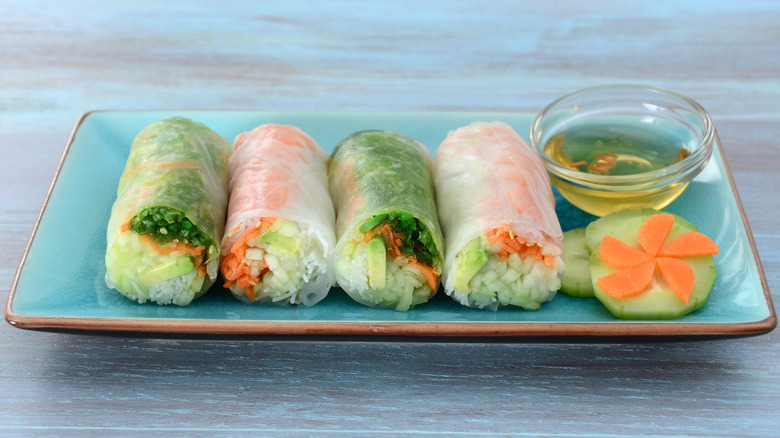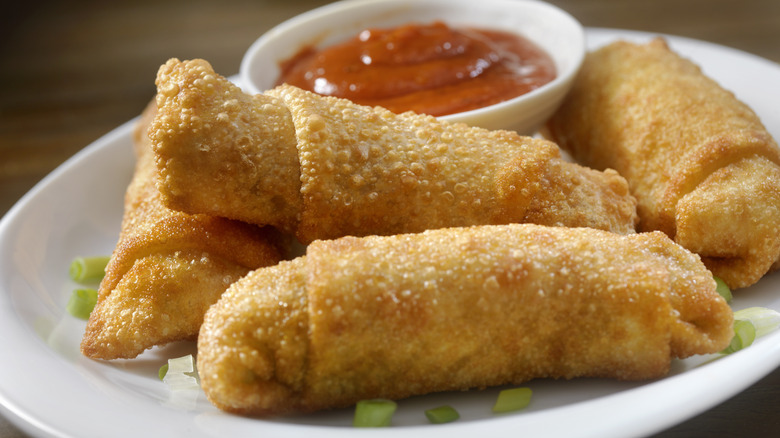Spring Roll Vs. Egg Roll: The Key Ingredient Differences
Do you ever see egg rolls and spring rolls on the menu at a Chinese restaurant and wonder how they're different? You're not alone. They're both crunchy, fried delights you might dip in a tasty sauce. But their ingredients and how they're prepared show exactly how they're different.
Spring rolls originally came from China, and experts hypothesize that the original version was probably a thin pancake wrapped around spring vegetables. You're more likely to find dough wrapped around a vegetable mixture before being fried to golden-brown perfection. There are also other regional variations on the spring roll that aren't fried. If you've eaten them in a Thai restaurant or Vietnamese restaurant, for instance, you'll notice that the wrapper is a soft, translucent rice paper that has a more flexible texture. And inside, you'll find a raw vegetable mixture.
Egg rolls, on the other hand, are commonplace in Chinese restaurants — but they aren't originally Chinese. It's thought that they were invented by Chinese-American restaurateurs to appease Westerners who came to eat Chinese food. When it comes to the two items, there are more than just cultural differences that separate them. Their ingredients play a big role as well.
Egg rolls and spring rolls have different wrappings
One of the key ingredients that make egg rolls and spring rolls so different is the types of wrappers used to make them. If you order spring rolls or make them at home, you'll likely encounter one of the two kinds of spring roll wrappers — the more traditional wheat wrappers that are often deep-fried, or the soft, translucent rice paper wrappers that are served raw.
Spring rolls are lighter than egg rolls — even the fried version — because the ingredients in the wrappers are less rich than egg roll wrappers. The texture when you take a bite is also different. Fried spring rolls will usually break under the bite of your teeth, offering a satisfying crunch factor.
Egg rolls, on the other hand, are made with a specific type of wheat-based wrapper that contains eggs (hence the name). When they hit the hot oil, they puff up and get the bubbles that give them their signature texture and appearance. The texture starts out crunchy, but then there's a bit of a chewy texture before you get to the filling. Because egg rolls puff up when fried, their texture is more reminiscent of other fried dough food items.
What's inside matters
The traditional fillings for spring rolls and egg rolls also differ. Spring rolls are, as the name suggests, filled with spring vegetables, such as carrots, cabbage, and mushrooms. Egg rolls generally pair richer fillings with the richer wrapper.
More often than not, spring rolls will be filled simply with vegetables. If they're fried, the vegetables will have a cooked texture. If the spring rolls are made with rice-based wrappers, they're likely to be served cold, with thinly sliced raw vegetables inside. While spring rolls often don't contain meat, it's not entirely unusual to find them filled with shrimp or even pork. When it comes to egg rolls, you're more likely to find them filled with meat. Pork and cabbage is a standard pairing for egg rolls, but depending on where you're eating them, you might find other ingredient combinations.
Some American restaurants will serve variations on egg rolls and fill them with more traditionally American ingredients, such as chicken, bacon, or avocado. Because egg rolls were most likely invented to appeal to American food preferences, experimenting with them would be less about breaking tradition and more about carrying on the lore.



